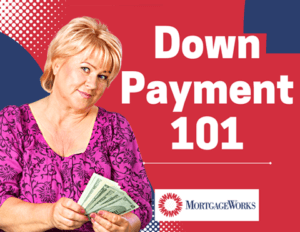Down payment is a significant hurdle for many aspiring homeowners.
The task of saving enough money to make that initial investment can seem daunting, especially when you’re already grappling with everyday expenses and financial commitments.
A substantial down payment could mean the difference between securing your dream home or settling for less. It impacts everything from mortgage rates to loan terms, ultimately shaping your entire home-buying journey.
In this complex landscape of real estate transactions, understanding how to effectively save for a down payment becomes crucial. With proper planning and strategic financial management, it’s an achievable goal, even amidst economic uncertainties.
Understanding the Concept of a Down Payment
Figuring out the details of buying a house can be intimidating, particularly with respect to comprehending down payments. However, grasping this concept is simpler than it may initially appear.
This article will guide you through the nuances of a down payment and its significance in purchasing your dream home.
Exploring Down Payments in Depth
So, what exactly is a down payment? Essentially, it refers to an upfront cash contribution made toward the purchase of a new property. This amount represents your initial investment in the house and helps mitigate the risk for lenders, making it an essential requirement for the payment process.
The amount of the initial payment can vary depending on elements like credit rating and type of loan. Making a higher upfront cash commitment often leads to better mortgage terms.
Recent improvements have been observed in mortgage rates, with the 10-year bond yield at 4.08%. These trends present prospective homeowners with opportunities to secure favorable financing conditions by optimizing their down payments.
Navigating these dynamics may feel challenging, but having clarity on how much to contribute as a down payment can facilitate effective planning for future financial obligations associated with homeownership.
Are you ready to delve deeper into how different down payment sizes impact not only mortgage insurance but also other aspects, such as loan terms and monthly repayments?
The Impact of a Down Payment on Your Mortgage

Understanding the impact of a down payment on your mortgage is crucial when navigating the complex world of home buying. By grasping key elements like down payments, you can simplify the process and make informed decisions.
Let’s delve into how your down payment affects important aspects such as private mortgage insurance, loan terms, and monthly payments.
A Larger Down Payment Improves Loan Terms
Have you ever wondered how a larger initial investment can enhance your borrowing experience? When you decrease your loan amount from day one, you reap several benefits.
First, an increased down payment reduces the overall amount you borrow. This translates to less interest paid over time, resulting in significant savings. It’s a simple yet effective strategy.
Another advantage of a larger down payment is the potential to avoid private mortgage insurance (PMI). PMI is typically required for loans with less than a 20% down payment, serving as a safety net for lenders against defaults. By making a higher upfront investment, you may be able to eliminate this additional cost altogether.
Larger Down Payments, Lower Monthly Payments
If you want to ensure manageable financial commitments, consider boosting your initial deposit. When you borrow a smaller amount, your monthly payments become more affordable. It’s a straightforward way to ease your financial burden.
Moreover, putting down a larger sum upfront can result in more savings over time. By taking into account future market trends, such as Zillow’s prediction of a 6.5% increase in U.S. home prices by July 2024, those who make bigger deposits now can potentially benefit from increased equity and lower interest costs.
Determinants of Down Payment Amounts
The amount required for a down payment is largely contingent upon one’s individual circumstances. Several key factors come into play, including the purchase price of the home and your credit score. These determinants will be explored in more detail in the following sections.
Key Takeaway:
Getting the lowdown on down payments is vital for a smooth home-buying journey. A heftier initial investment can sweeten your loan terms, curb monthly payments and possibly ditch private mortgage insurance. The size of your down payment hinges largely on personal factors like home price and credit score.
Understanding the Factors that Determine Down Payment Amounts
Embarking on the journey to homeownership requires a clear understanding of the key factors that influence your down payment. One of the most significant determinants is the purchase price of the property. Lenders typically require a down payment ranging from 3.5% to 20% of the sales price.
The larger the purchase price, naturally, the more substantial your required down payment may be.
The amount of your down payment is heavily influenced by your credit score, with those having higher scores needing to contribute less upfront and vice versa. A higher credit score can lead to a lower requirement, as lenders perceive less risk. Conversely, individuals with lower credit scores may need to contribute more upfront.
The Impact of Debt-to-Income Ratio (DTI)
Another factor that comes into play is your debt-to-income ratio (DTI). This ratio compares your debt to your income and helps lenders determine the loan amount and subsequent down payment requirements.
If your debt is relatively low compared to your income (low DTI), you can expect more flexibility in down payment options.
On the other hand, higher DTIs may result in higher initial costs when purchasing a home.
Rising Rents and Soaring Home Prices: A Case Study in California

In California, where the median rent is an exorbitant $3,000 per month, becoming a homeowner can be financially challenging due to the upfront expenses associated with home acquisition.
Navigating Your Path to Homeownership
Understanding the factors that determine the initial investment, such as the down payment, can help you develop effective strategies for saving toward your dream home.
Stay tuned. In our next segment, we will delve into effective savings strategies that prospective homeowners can utilize.
Strategies for Saving for a Down Payment
The journey to homeownership begins with a crucial first step: saving for a down payment. But how can you effectively navigate this financial endeavor?
Savings Account and Emergency Fund: Twin Pillars of Financial Security
A savings account, specifically dedicated to your home purchase, is the foundation of any successful strategy. By tracking your progress toward your goal in a separate account, you can stay focused on achieving it.
An emergency fund serves as a safety net during unforeseen circumstances. Ensuring its existence alongside your down payment savings account guarantees that unexpected expenses don’t derail your dream.
Checking Account Management: The Unsung Hero
Your checking account plays a vital role in managing daily expenses, but it can also facilitate greater funds transfer into your designated savings accounts mentioned earlier.
Diverse Payment Savings Strategies – One Size Does Not Fit All
We all have different saving habits – some prefer regular monthly contributions, while others opt for lump-sum deposits when feasible. Trying out different strategies helps identify the most efficient way to reach your target amount.
Cutting back on unnecessary expenditures could be one way.
Finding additional income sources, such as part-time jobs or freelance work, might suit others better.
In either case, every extra dollar saved brings you closer to owning that dream house.
As we delve deeper into this topic, we’ll also explore external resources available that can provide significant assistance in gathering enough money required for down payments.
Next up are these very assistance programs.
The Role of Assistance Programs in Securing Your Down Payment
When embarking on the journey to homeownership, a major roadblock many first-time homebuyers encounter is gathering sufficient funds for a down payment. However, there exists an array of assistance programs that can help ease this financial burden.
Federal Aid: Government Programs
In our nation’s capital, several federal agencies have taken steps to assist prospective homeowners. The Federal Housing Administration (FHA), for instance, offers loans with less stringent down payment requirements than traditional mortgages—making owning property more accessible for those without hefty savings.
Government aid often proves invaluable in making the dream of homeownership achievable.
Your Local Heroes: State and Local Programs
State and local governments often offer their residents various forms of support, with certain criteria such as income limits or geographic restrictions. These initiatives frequently come equipped with eligibility criteria, including income limits or stipulations regarding geographic areas where one resides.
A Helping Hand: Grants and Loans from Non-Profits
Beyond government-backed efforts are non-profit organizations dedicated to offering grants or loans designed specifically to aid individuals in meeting their down payment goals. Such resources can significantly reduce the upfront costs associated with buying your dream home. However, each program comes packaged with its own set of rules and eligibility guidelines, which must be thoroughly understood before application submission begins.
Navigating Closing Costs and Other Expenses
Purchasing real estate isn’t just about securing your down payment—it’s also about understanding closing costs along with other expenses tied into it all. Recent data points out that the core PCE (personal consumption expenditure) index ticked up, indicating rising household spending related to housing expenditures. Our next section will delve deeper into these additional charges as well as strategies you can employ effectively when purchasing your new abode.
Key Takeaway:
Securing a down payment for your dream home in the Coachella Valley can seem daunting, but don’t fret. Assistance programs from federal to local levels and even non-profits are ready to lend a hand. These resources ease the financial burden by offering loans or grants with flexible terms. Just remember, it’s not just about the down payment – understanding closing costs and other expenses.
Understanding Closing Costs and Other Expenses
Embarking on the journey of homeownership can be an exciting yet complex process. One crucial aspect to grasp is the concept of closing costs, along with other additional expenses.
Breaking Down Closing Costs
Closing costs encompass various charges, such as loan origination fees, appraisal fees, title insurance, and escrow fees. The percentage of closing costs can vary depending on the location or lender policies, usually between 2% and 5% of your loan amount.
Having knowledge about these expenses empowers buyers to make informed decisions when selecting lenders.
The Impact of the Core PCE Index on Housing Market Trends
A significant factor influencing housing market trends, including mortgage interest rates, is the core Personal Consumption Expenditure (PCE) index. This index can affect your total cost at closure, potentially altering your overall expenditure.
Recent upward movements in this index indicate potential inflationary pressures that could lead to higher mortgage interest rates over time.
Additional Considerations: Home Inspection and Property Taxes
Beyond closing costs, there are other important considerations, such as property taxes, that need to be factored into your budget for homeownership.
Conducting a thorough home inspection is a crucial step in the purchase process. A reputable inspector will identify any potential issues with the property before finalizing the transaction, helping you avoid unexpected repair bills after the purchase.
It is essential to consider potential tax implications, as they can vary significantly depending on local regulations and the value of your new home.
Homeowner’s insurance premiums are often overlooked but play a significant role in monthly payments and overall affordability.
Conclusion
The amount you put forth can have a significant impact on your mortgage insurance, loan terms, and monthly payments. Your credit score and purchase price are key factors in determining the down payment amount. Developing effective saving strategies can help alleviate the financial burden. Additionally, there are assistance programs available that can provide valuable support in securing the necessary down payment. It’s also important to carefully navigate closing costs and other expenses associated with buying a home. By arming yourself with this knowledge, you’ll be better equipped to make informed decisions on your path to homeownership in the Coachella Valley.


